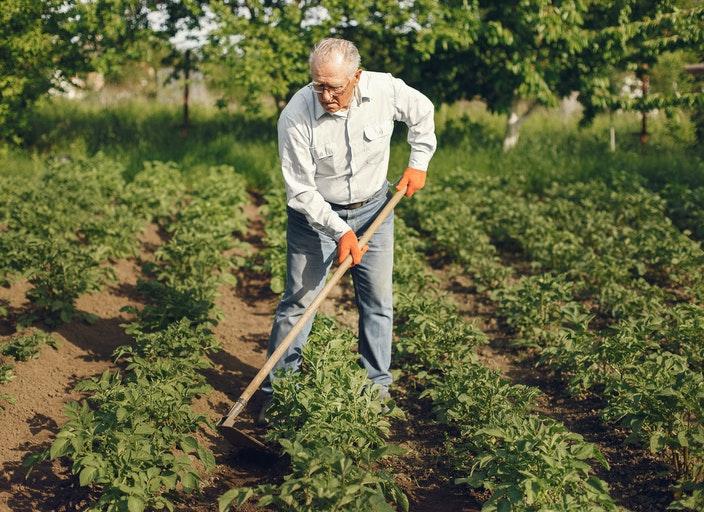

Are you interested in planting a garden but unsure of where to start? You should read this article about gardening for beginners since it contains 8 easy steps to get you started.
This may sound familiar to you. I saw weeds, overgrown vegetation, and a few dried-out pots in my yard where I had attempted to grow tomatoes the previous year. How am I going to grow anything here, I ask myself. What should I start with? How am I going to know what to plant? "Will a garden be worth the time and money I invest in it?"
Take a look at these instructions before trying them out. You are capable of doing this.



Step 1: Determine where to start your garden.
The ideal location is one that is handy for you—somewhere you will often see and pass by. Although the garden in the rear of the yard, behind the shed, may get the most sunlight, if you don't consistently visit it, you could forget about it. Looking for a location with at least 6 to 8 hours of daylight is ideal for this site, which ideally receives morning sun (more is ok). In warmer places like Arizona, you may need to give shade throughout the summer. Use the Sun Seeker app to check your sun exposure (or similar). gives you the ability to check how much sunshine each region gets. Additionally, there should be a water supply nearby or accessible via hose.Step 2: Add a raised bed
You can always add more when you start small. A raised bed that is "4 feet by 4 feet" is a nice place to start. Attempt to reach a depth of 12 to 18 inches. It is simple to build and has enough room to produce a lot of food. You must be able to reach into the bed's middle without walking on the ground. Later, as your knowledge and expertise increase, add additional raised beds. Tips for creating raised bed gardens are provided in this article. Alternately, for container growing, use many large pots or half wine barrels.Step 3: Install an irrigation system
It is ideal to water seedlings using an automated irrigation system and a hose. Simple methods for automatic watering include connecting a battery-operated timer to your hose bib and using a soaker hose or drip irrigation system to water your garden. For hand-watering fresh seedlings and seeds, a two-way splitter for a second hose is useful.
Step 4: Fill your raised bed with dirt.
Raised beds have the benefit of not using existing soil. You are prepared to plant after you have added the ideal combination of elements to your raised bed. The most costly component of starting a garden will probably be this one-time expenditure. Mix the following ingredients in an equal ratio to fill the bed: Use a variety of brands of compost or create your own. Peat moss or coconut coir - assists with water retention and lightens the soil. Vermiculite - aids in water retention and promotes soil airflow. What much of dirt do you need? The size of your raised bed or containers will decide this. 16 cubic feet of dirt will be required to fill a 44 bed that is 1 foot deep. When you plant, amend your soil with new compost. More details about the ideal soil for raised bed gardens are provided in this article. Organic fertilizer should be added to the beds once the soil is added. I make fresh raised beds with organic fertilizer using this formula. In the future, it will be crucial to test your soil annually. Your soil's health may be ascertained by a soil test. I use a kit like this to test the soil. It is quite easy to use.
Step 5: Locate a planting manual created for your region and adhere to it.
Gardening requires the use of timing. Making decisions on what to plant and when to plant it is simplified by using a planting guide. You should start your search for a planting guide at local extension offices and locally owned nurseries.Step 6: Plant foods you like eating.
Root vegetables (carrots, turnips, radishes, etc.), peas, beans, maize, squash, melons, cucumbers, and Swiss chard are best grown from seed. Brussels sprouts, tomatoes, and peppers are the best as seedlings. Broccoli, cabbage, cauliflower, lettuce, kale, and spinach are all good choices. Check fresh seeds and seedlings often, and water as needed to maintain a wet soil environment. Newly planted seeds and seedlings will perish if they get too dry.
Step 7: Spend some time each day in your garden.
Every morning, stroll around your garden, ideally when the irrigation system is on. Take note of what is flourishing (hurray!) and keep an eye out for issues while they are still little and manageable. Difficulties (such as pests, diseases, and irrigation problems) are simple to handle while they are little. Enjoy your accomplishments and take lessons from your mistakes.Step 8: Gather and consume your harvest
Pick early and often to promote more output. Utilize the produce from your garden. Try out new recipes and add the produce from your garden to the meals your family currently enjoys. Using garden veggies in soups and smoothies is a terrific idea.
文章
sososo和atastybellpepper赞了


共3条评论


atastybellpepper
2022-07-12
0
awesome

sososo
2022-07-12
0
This article is really useful for me!

sososo
2022-07-12
0
This article is so well written!








